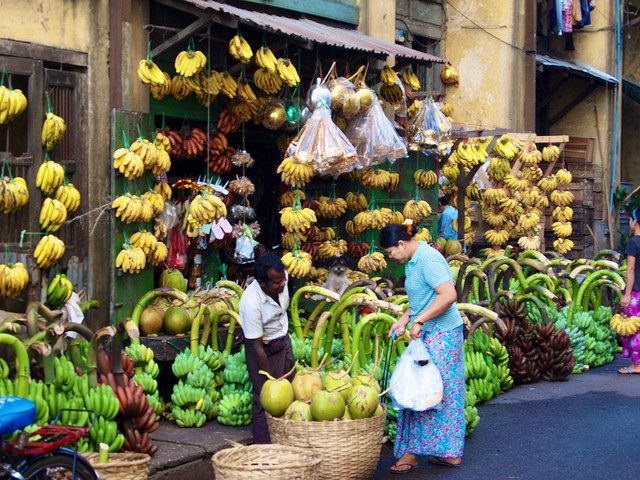[dt_button link=”http://d165vjqq8ey7jy.cloudfront.net/mp3/20090/se-7703s.mp3″ target_blank=”true” button_alignment=”default” animation=”fadeIn” size=”small” style=”default” bg_color_style=”custom” bg_color=”#333333″ bg_hover_color_style=”custom” bg_hover_color=”#444444″ text_color_style=”custom” text_color=”#ffffff” text_hover_color_style=”custom” text_hover_color=”#dddddd” icon=”fa fa-cloud-download” icon_align=”left”]Yuklash[/dt_button]
[dt_divider style=”thin” /]
Transcript:
Voice 1
Welcome to Spotlight. I’m Liz Waid.
Voice 2
And I’m Adam Navis. Spotlight uses a special English method of broadcasting. It is easier for people to understand, no matter where in the world they live.
Voice 1
The banana farm looks like many other banana farms. It is in the Central American country Honduras. The plants are tall and green. And each holds banana fruits – long, thin and yellow. The bananas grow in large groups, called bunches. Soon, people will pick them, to eat. However, this farm is different from many other large banana farms. Most large banana farms grow just one kind of banana – the Cavendish banana. But this farm has more than 300 different kinds of banana plants. That is because the farmers and scientists at this farm are looking for the perfect banana.
Voice 2
Bananas are the most popular fruit in the world. People around the world eat more than 100,000,000,000 bananas every year. It is a big business. But it is also an important small business. In local markets, it is a healthy food for many poor people. Today’s Spotlight is on the banana.
Voice 1
People have been eating bananas for more than 15,000 years. Bananas are originally from the Malaysian rain forests of Southeast Asia. But 500 years ago, Portuguese settlers brought bananas to many other countries.
In all of these places, people developed new kinds of bananas. They also created new ways to cook and eat bananas! Some bananas are best to eat raw, without cooking. But other bananas are delicious to eat fried in oil.
Voice 2
In the country of Uganda, people call bananas “matoke”. Matoke is a common food at the afternoon meal. People steam unripe green bananas over boiling water. Then they mash the bananas into a thick mixture. They eat matoke with meat and sauce.
Voice 1
In Indonesia, people cook with banana leaves. They put food like fish or rice into the leaves. Then they cook the food inside the leaves. When the food is done, a person opens the leaves and eats the food!
Voice 2
In Honduras, people eat plaintain chips. These chips are thinly cut pieces of banana. People fry these pieces in oil. Then they add salt. The chips are a great snack to eat between meals.
Voice 1
All of these bananas are good for the human body. They contain vitamins and minerals that people need to stay healthy. For many people in the world, bananas are a good way to get these healthy substances. This is especially true because bananas grow through the whole year. People can always get a banana!
Voice 2
This also makes bananas an important crop for farmers. However, bananas are also a big business. Big companies grow bananas on large farms, with thousands of plants.
Voice 1
But these farms all grow only one kind of banana: the Cavendish. Cavendish bananas do not taste the best. They do not have the best quality. There are many, many better bananas. So why do people even grow them? It is because the Cavendish is easy to grow in large numbers. The skin is thick. It does not damage easily. It is easy to transport the Cavendish banana long distances – from growing areas to every country in the world. This is what makes it the most popular banana.
Voice 2
Like most bananas, the Cavendish banana does not grow from seeds. Instead, small baby plants grow up from the base of the parent plant. Farmers take these baby plants and grow them in another place. As a result, large banana farms are filled with many plants that are exactly the same. But this method of banana farming causes many problems.
Voice 1
When plants are all exactly the same, they can pass diseases very easily and quickly. This is what has happened in the Cavendish banana farms. Two diseases are threatening bananas – these diseases may even cause Cavendish bananas to die out completely.
Voice 2
The first disease affecting Cavendish bananas is Black Sigatoga. Farmers use chemicals to kill this disease. But the chemicals hurt the people who use them. Their babies are not born healthy. The chemicals can cause skin and eye problems, and cancer. These chemicals stop Black Sigatoga, but they cause many other problems.
Voice 1
The second disease is Panama disease. It is even more serious. It is spread through diseased plants. When a farm gets Panama disease, the banana plants all die. In the 1950s, Panama disease completely destroyed another popular kind of banana – the Gros Michel. In the past, the Cavendish banana plant could avoid the disease. But now, Panama disease has adapted and changed. It attacks Cavendish bananas too. Many experts agree that it will probably destroy all Cavendish banana farms. Farmers will have to find another new kind of banana to grow.
Voice 2
This brings us back to the banana farm we described at the beginning of today’s program. This banana farm is operated by the Honduran Foundation for Agricultural Investigation, or FHIA. Scientists at the FHIA farm are growing new kinds of bananas. They use traditional methods to breed the plants. Bananas do make some seeds. So the scientists look for these seeds. They crush many bananas to get a few seeds. Then they use the seeds to plant new bananas. They are looking for very particular qualities. These bananas need to be strong, to resist diseases. But they must also be easy to grow. They must taste good. They must be a good size. And they must be easy to transport over long distances. There are many different kinds of bananas already in the world, but it is difficult to grow a banana that has all of these qualities!
Voice 1
These scientists have already had some successes. They have developed new kinds of bananas that are popular in Australia, and in Central America. But they have not found a banana to replace the Cavendish. Juan Fernando Aguilar manages this project. He does not think that they will find just one kind of banana. Instead, he thinks that the future will include many kinds of bananas. People will have to learn to eat more than just the Cavendish.


